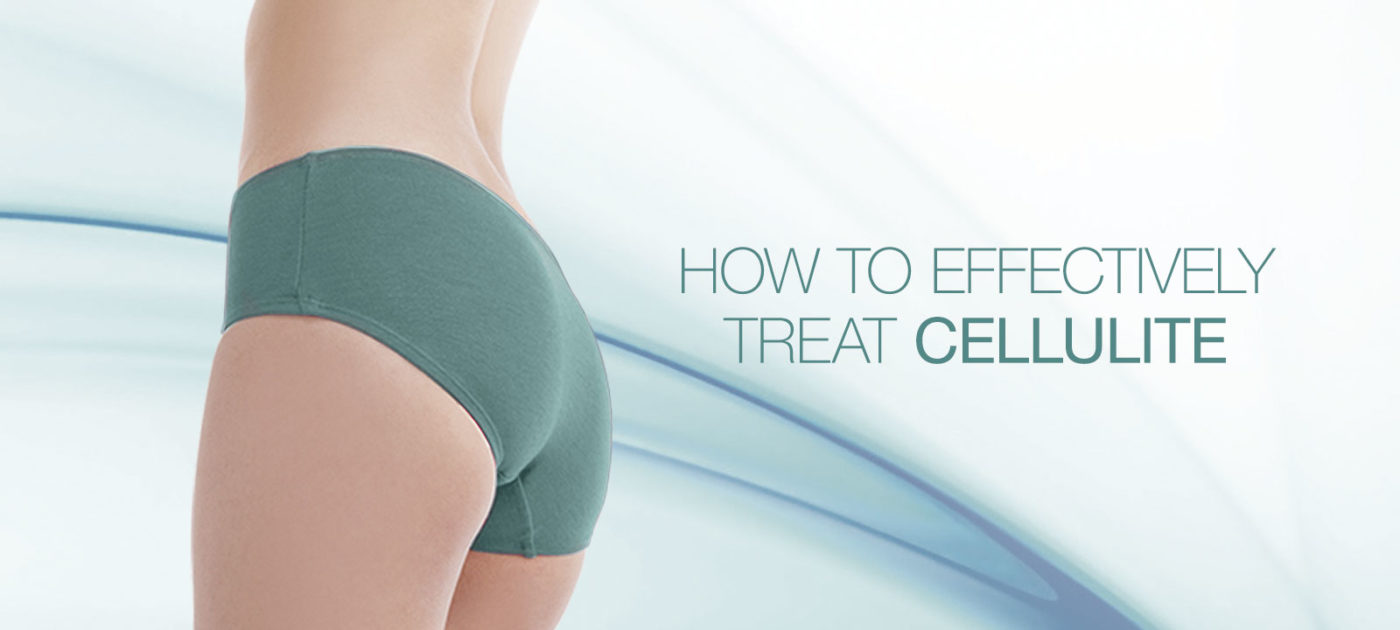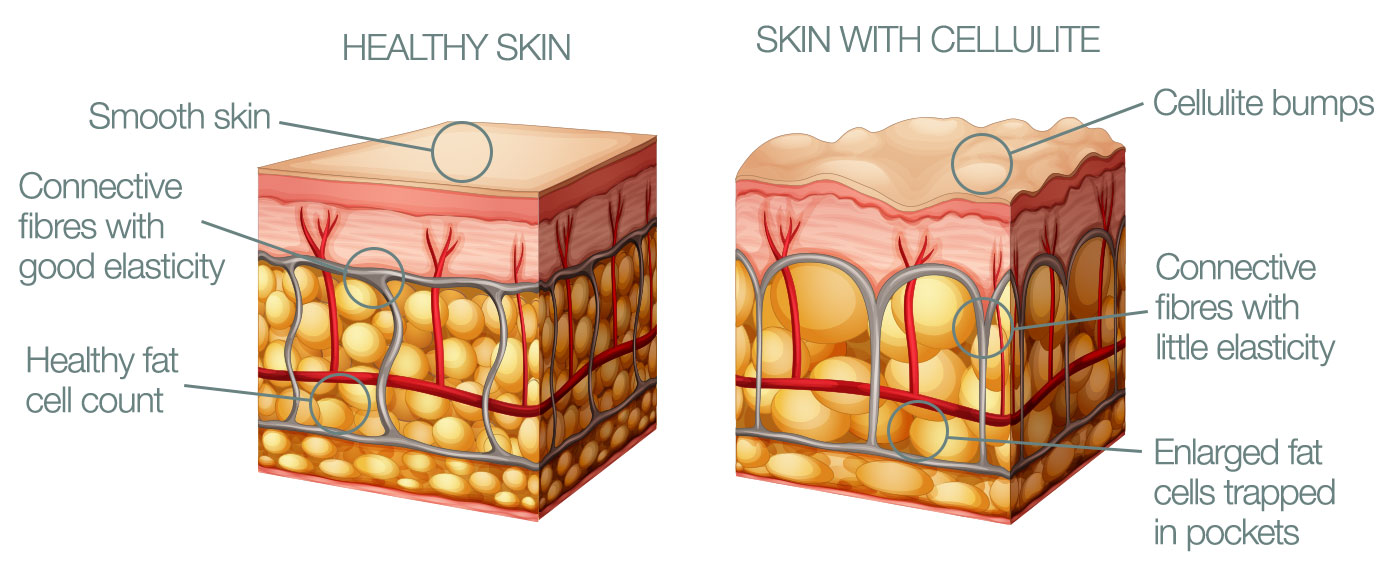The term cellulite in the Oxford Dictionary is listed as “persistent subcutaneous fat causing dimpling of the skin, especially on women’s hips and thighs.”
Yes thanks dictionary we know where it is but you forgot to mention that we can also get it on our derrières and we know exactly what it looks like as we live with it every day. What we really need to know is why do we get it and most importantly how do we treat it.
A few facts about cellulite worth knowing
- Cellulite is a very common problem that affects 90 percent of women and 10 percent of men.
- More women are affected by cellulite due to the structure of their collagen fibers. (Women’s sit in vertical lines as opposed to men’s which are criss cross.)
- The ‘orange peel look” that appears underneath the skin occurs when fat and fluid build up in pockets between the collagen fibers.
- Cellulite is not a necessarily a sign of being overweight. Toned, healthy people are often affected.
- Genetics have a lot to do with cellulite, therefore it’s easier for some to reduce cellulite than others.
- There are three main types of cellulite, in order to see results you need to address all three.
The science behind cellulite
Before we get to treating the problem, it’s important to understand cellulite to its full extent. Cellulite is not just about fat. It is a combination of trapped fat cells, weakened collagen fiber and fluid retention. These are the three main types:
Adipose Cellulite
Caused by the increase in size and number of fat cells.
Adipocytes (fat cells) make up adipose tissue, the area where energy is stored as fat. We need this fat to say healthy. Depending on the stimuli that the adipocytes receive, they will multiply and store more fat or decrease and store less fat.
Cellulite occurs when the adipocytes store more fat then the body needs, they then get trapped inside pockets between the collagen fibres. This imbalance is usually due to diet: eating large amounts of refined sugars, processed foods; regularly eating more calories than you burn or drinking lots of alcohol.
Fibrous Cellulite
Caused by structural changes and weakening of the collagen fibers.
When collagen fibers beneath the skin become weak or lose their elasticity, underlying fat deposits start to push through the layers of fibers causing bumps under the skin. Collagen fibers and connective tissue can become weak for a number of reasons such as lack of muscle tone, ageing, sun damage, excess fat, hormones and poor circulation.
Infiltrated Cellulite
Caused by poor circulation & liquid retention.
The walls of the blood vessels are formed by an elastic tissue that allows a fluid circulation of the blood. When these walls lose elasticity, the speed of the blood circulation is reduced. Instead of being excreted, excess fluids and waste products get pushed towards the adipocyte tissue where they attach to the fat cells causing cellulite and swelling. The transportation of oxygen and nutrients is also reduced causing the metabolism to slow down.
The weakening of the vascular walls does naturally occur with age but can also be affected by a number of lifestyle choices such as lack of regular exercise, smoking, stress, sitting for long periods of time or eating foods high in salt.
Effectively Treating Cellulite
Unfortunately, there’s no quick fix for treating cellulite long term. Achieving serious improvements will take time, consistency and a combination of lifestyle adjustments. If you eliminate the cellulite but do not deal with the bad circulation it will appear again. Here’s a few solutions:
Anti-Cellulite Creams: Can target all three types of cellulite
Applying a good anti-cellulite cream twice a day (in conjunction with other solutions) will help to reduce cellulite. Look for products that target at least two types of cellulite and that work to prevent it as well as reduce it. Look for some of these ingredients: Astragalus Extract is effective at preventing the formation of new fat cells; Centella Asiatica helps to restore the skin’s elastic quality; Ginkgo Biloba helps to increase blood circulation; Lemon Extract help to protect the walls of the blood vessels to prevent swelling. We recommend Germaine de Capuccini’s Slim Precision Anti-cellulite Emulsion.
Tip: Apply your cream after exercise for better results – the product will absorb more effectively as your blood circulation is stimulated.
Brisk walking: Targets Infiltrated Cellulite
Cellulite forms in areas with the least circulation so simple exercises such as brisk walking, swimming and running should be done daily to help increase blood circulation in the whole body. As little as 10 minutes a day can make a positive difference.
Weight Training: Targets Fibrous Cellulite
Weight training is a great way to strengthen the connective fibers and tone the muscles. It allows you to target certain areas and work the muscles much more intensely than cardio training can. It also burns fat a lot excess of fat too.
Supplements: Can target all three types of cellulite
Carefully chosen supplements are a good way to target cellulite from inside by helping to degrade fat cells, drain waste and strengthen fibrous tissue. Look for ingredients that help with drainage such as Horsetail and ingredients containing caffeine to help burn fat. Be sure to avoid anything with sugar or nasty additives.
Massage: Can target all three types of cellulite
A course of professional massage treatments can have extremely positive short term effects on cellulite. For best results, look for treatments that combine drainage massage techniques to improve blood circulation combined with products that help to rebuild the strengthen the connective tissue and reduce fat cells (targeting all 3 types of cellulite).
Diet: Targets Adipose Cellulite
Avoid high amounts of refined sugar, processed foods, while carbohydrates and foods that contain sweeteners, additives and chemicals. These all convert to sugar within the body and get stored easily consequently causing the fat tissue to expand. Drinking water and eating foods with a high water content will also keep your connective tissue strong and supple.







